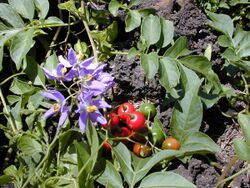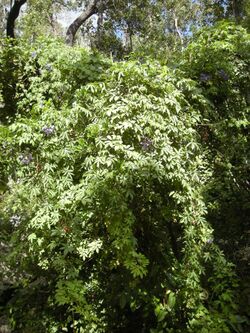Biology:Solanum seaforthianum
| Solanum seaforthianum | |
|---|---|

| |
| Scientific classification | |
| Kingdom: | Plantae |
| Clade: | Tracheophytes |
| Clade: | Angiosperms |
| Clade: | Eudicots |
| Clade: | Asterids |
| Order: | Solanales |
| Family: | Solanaceae |
| Genus: | Solanum |
| Species: | S. seaforthianum
|
| Binomial name | |
| Solanum seaforthianum | |
Solanum seaforthianum, the Brazilian nightshade,[3] is a flowering evergreen vine of the family Solanaceae native to tropical South America. As a member of the Solanum genus, it is related to such plants as the tomato and potato. It is characterized by clusters of four to seven leaves and can climb to a height of 6 m (20 ft) given enough room. It blooms in the mid to late summer with clusters of star-shaped purple inflorescence followed by scarlet marble-sized berries. The plant is highly heat resistant, but cannot tolerate frost conditions. The plant contains modest amounts of various tropane alkaloids such as atropine, scopolamine and hyoscyamine and should be considered mildly toxic and inedible.[4] Promising molluscicidal and schistosomicidal activities were displayed for the S. seaforthianum extracts and fractions which are attributed to the glycoalkaloid content.[5]
The species has become widely naturalised outside its native range and is an invasive species in Australia , Africa, Indochina, the Pacific Islands and India , choking native vegetation and poisoning livestock.[6]
References
- ↑ "Solanum seaforthianum Andrews". The Trustees of the Royal Botanic Gardens, Kew. n.d.. https://powo.science.kew.org/taxon/urn:lsid:ipni.org:names:316949-2.
- ↑ "Solanum seaforthianum Andrews". Species 2000. n.d.. https://www.catalogueoflife.org/data/taxon/4Y47B.
- ↑ "Solanum seaforthianum". Natural Resources Conservation Service PLANTS Database. USDA. https://plants.usda.gov/core/profile?symbol=SOSE7. Retrieved 17 November 2015.
- ↑ Janaki-Ammal, E.K.; Viswanathan, T.V. (1975). "A new garden plant for India: tetraploid Solanum seaforthianum". Indian Horticulture Sept 1975: 25.
- ↑ "Comparative Molluscicidal and Schistosomicidal Potentiality of Two Solanum Species and Its Isolated Glycoalkaloids.". Pharmacognosy Research 10 (1): 113–117. 19 Feb 2018. doi:10.4103/pr.pr_71_17. PMID 29568198. PMC 5855367. http://www.phcogres.com/text.asp?2018/10/1/113/225822. Retrieved 25 February 2018.
- ↑ "Factsheet - Solanum seaforthianum (Brazilian Nightshade)". lucidcentral.org. http://keys.lucidcentral.org/keys/v3/eafrinet/weeds/key/weeds/Media/Html/Solanum_seaforthianum_%28Brazilian_Nightshade%29.htm.
External links
Wikidata ☰ Q3024467 entry
 |


